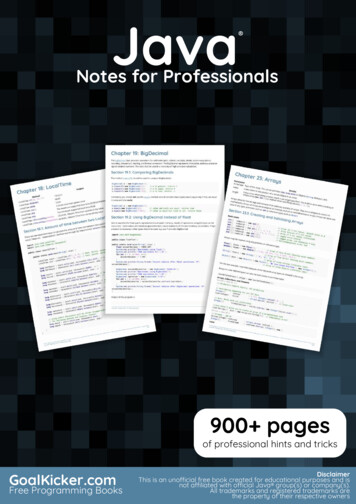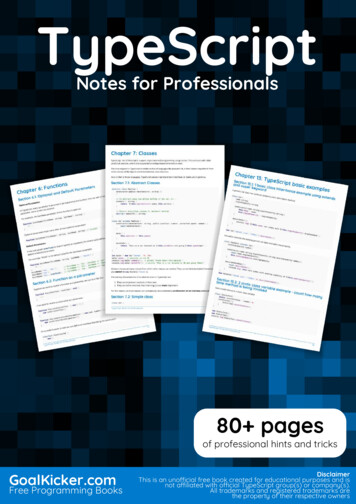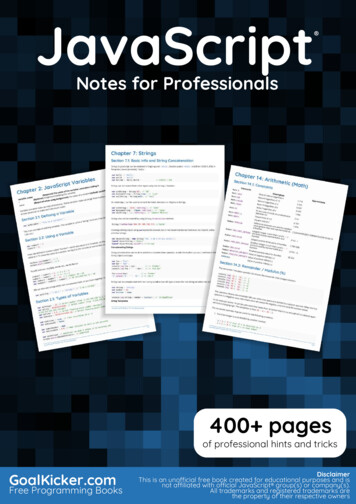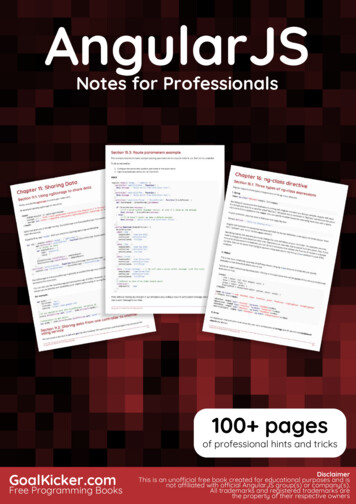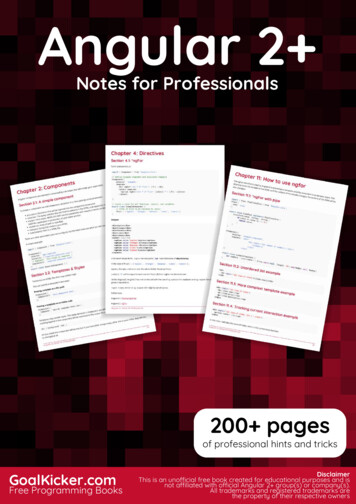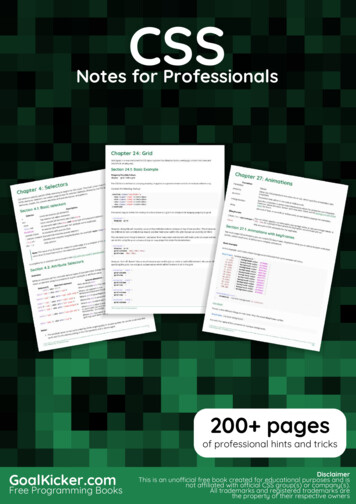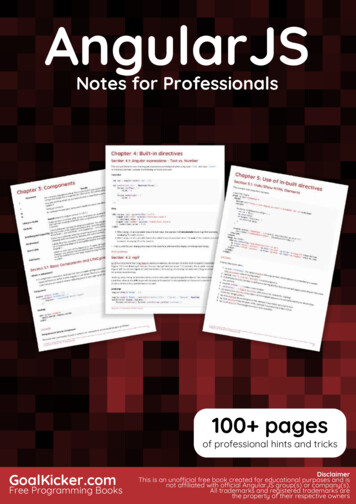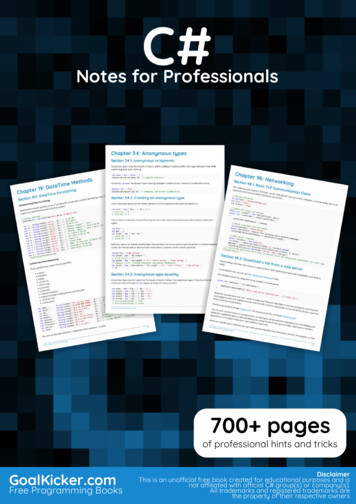
Transcription
C#C#Notes for ProfessionalsNotes for Professionals700 pagesof professional hints and tricksGoalKicker.comFree Programming BooksDisclaimerThis is an uno cial free book created for educational purposes and isnot a liated with o cial C# group(s) or company(s).All trademarks and registered trademarks arethe property of their respective owners
ContentsAbout . 1Chapter 1: Getting started with C# Language . 2Section 1.1: Creating a new console application (Visual Studio) . 2Section 1.2: Creating a new project in Visual Studio (console application) and Running it in Debug mode. 4Section 1.3: Creating a new program using .NET Core . 7Section 1.4: Creating a new program using Mono . 9Section 1.5: Creating a new query using LinqPad . 9Section 1.6: Creating a new project using Xamarin Studio . 12Chapter 2: Literals . 18Section 2.1: uint literals . 18Section 2.2: int literals . 18Section 2.3: sbyte literals . 18Section 2.4: decimal literals . 18Section 2.5: double literals . 18Section 2.6: float literals . 18Section 2.7: long literals . 18Section 2.8: ulong literal . 18Section 2.9: string literals . 19Section 2.10: char literals . 19Section 2.11: byte literals . 19Section 2.12: short literal . 19Section 2.13: ushort literal . 19Section 2.14: bool literals . 19Chapter 3: Operators . 20Section 3.1: Overloadable Operators . 20Section 3.2: Overloading equality operators . 21Section 3.3: Relational Operators . 22Section 3.4: Implicit Cast and Explicit Cast Operators . 24Section 3.5: Short-circuiting Operators . 25Section 3.6: ? : Ternary Operator . 26Section 3.7: ?. (Null Conditional Operator) . 27Section 3.8: "Exclusive or" Operator . 27Section 3.9: default Operator . 28Section 3.10: Assignment operator ' ' . 28Section 3.11: sizeof . 28Section 3.12: ? Null-Coalescing Operator . 29Section 3.13: Bit-Shifting Operators . 29Section 3.14: Lambda operator . 29Section 3.15: Class Member Operators: Null Conditional Member Access . 31Section 3.16: Class Member Operators: Null Conditional Indexing . 31Section 3.17: Postfix and Prefix increment and decrement . 31Section 3.18: typeof . 32Section 3.19: Binary operators with assignment . 32Section 3.20: nameof Operator . 32Section 3.21: Class Member Operators: Member Access . 33Section 3.22: Class Member Operators: Function Invocation . 33
Section 3.23: Class Member Operators: Aggregate Object Indexing . 33Chapter 4: Conditional Statements . 34Section 4.1: If-Else Statement . 34Section 4.2: If statement conditions are standard boolean expressions and values . 34Section 4.3: If-Else If-Else Statement . 35Chapter 5: Equality Operator . 36Section 5.1: Equality kinds in c# and equality operator . 36Chapter 6: Equals and GetHashCode . 37Section 6.1: Writing a good GetHashCode override . 37Section 6.2: Default Equals behavior . 37Section 6.3: Override Equals and GetHashCode on custom types . 38Section 6.4: Equals and GetHashCode in IEqualityComparator . 39Chapter 7: Null-Coalescing Operator . 41Section 7.1: Basic usage . 41Section 7.2: Null fall-through and chaining . 41Section 7.3: Null coalescing operator with method calls . 42Section 7.4: Use existing or create new . 43Section 7.5: Lazy properties initialization with null coalescing operator . 43Chapter 8: Null-conditional Operators . 44Section 8.1: Null-Conditional Operator . 44Section 8.2: The Null-Conditional Index . 44Section 8.3: Avoiding NullReferenceExceptions . 45Section 8.4: Null-conditional Operator can be used with Extension Method . 45Chapter 9: nameof Operator . 47Section 9.1: Basic usage: Printing a variable name . 47Section 9.2: Raising PropertyChanged event . 47Section 9.3: Argument Checking and Guard Clauses . 48Section 9.4: Strongly typed MVC action links . 48Section 9.5: Handling PropertyChanged events . 49Section 9.6: Applied to a generic type parameter . 49Section 9.7: Printing a parameter name . 50Section 9.8: Applied to qualified identifiers . 50Chapter 10: Verbatim Strings . 51Section 10.1: Interpolated Verbatim Strings . 51Section 10.2: Escaping Double Quotes . 51Section 10.3: Verbatim strings instruct the compiler to not use character escapes . 51Section 10.4: Multiline Strings . 52Chapter 11: Common String Operations . 53Section 11.1: Formatting a string . 53Section 11.2: Correctly reversing a string . 53Section 11.3: Padding a string to a fixed length . 54Section 11.4: Getting x characters from the right side of a string . 55Section 11.5: Checking for empty String using String.IsNullOrEmpty() and String.IsNullOrWhiteSpace(). 56Section 11.6: Trimming Unwanted Characters O the Start and/or End of Strings . 57Section 11.7: Convert Decimal Number to Binary,Octal and Hexadecimal Format . 57Section 11.8: Construct a string from Array . 57Section 11.9: Formatting using ToString . 58Section 11.10: Splitting a String by another string . 59
Section 11.11: Splitting a String by specific character . 59Section 11.12: Getting Substrings of a given string . 59Section 11.13: Determine whether a string begins with a given sequence . 59Section 11.14: Getting a char at specific index and enumerating the string . 59Section 11.15: Joining an array of strings into a new one . 60Section 11.16: Replacing a string within a string . 60Section 11.17: Changing the case of characters within a String . 60Section 11.18: Concatenate an array of strings into a single string . 61Section 11.19: String Concatenation . 61Chapter 12: String.Format . 62Section 12.1: Since C# 6.0 . 62Section 12.2: Places where String.Format is 'embedded' in the framework . 62Section 12.3: Create a custom format provider . 62Section 12.4: Date Formatting . 63Section 12.5: Currency Formatting . 64Section 12.6: Using custom number format . 65Section 12.7: Align left/ right, pad with spaces . 65Section 12.8: Numeric formats . 66Section 12.9: ToString() . 66Section 12.10: Escaping curly brackets inside a String.Format() expression . 67Section 12.11: Relationship with ToString() . 67Chapter 13: String Concatenate . 68Section 13.1: Operator . 68Section 13.2: Concatenate strings using System.Text.StringBuilder . 68Section 13.3: Concat string array elements using String.Join . 68Section 13.4: Concatenation of two strings using . 69Chapter 14: String Manipulation . 70Section 14.1: Replacing a string within a string . 70Section 14.2: Finding a string within a string . 70Section 14.3: Removing (Trimming) white-space from a string . 70Section 14.4: Splitting a string using a delimiter . 71Section 14.5: Concatenate an array of strings into a single string . 71Section 14.6: String Concatenation . 71Section 14.7: Changing the case of characters within a String . 71Chapter 15: String Interpolation . 73Section 15.1: Format dates in strings . 73Section 15.2: Padding the output . 73Section 15.3: Expressions . 74Section 15.4: Formatting numbers in strings . 74Section 15.5: Simple Usage . 75Chapter 16: String Escape Sequences . 76Section 16.1: Escaping special symbols in string literals . 76Section 16.2: Unicode character escape sequences . 76Section 16.3: Escaping special symbols in character literals . 76Section 16.4: Using escape sequences in identifiers . 76Section 16.5: Unrecognized escape sequences produce compile-time errors . 77Chapter 17: StringBuilder . 78Section 17.1: What a StringBuilder is and when to use one . 78Section 17.2: Use StringBuilder to create string from a large number of records . 79
Chapter 18: Regex Parsing . 80Section 18.1: Single match . 80Section 18.2: Multiple matches . 80Chapter 19: DateTime Methods . 81Section 19.1: DateTime Formatting . 81Section 19.2: DateTime.AddDays(Double) . 82Section 19.3: DateTime.AddHours(Double) . 82Section 19.4: DateTime.Parse(String) . 82Section 19.5: DateTime.TryParse(String, DateTime) . 82Section 19.6: DateTime.AddMilliseconds(Double) . 83Section 19.7: DateTime.Compare(DateTime t1, DateTime t2 ) . 83Section 19.8: DateTime.DaysInMonth(Int32, Int32) . 83Section 19.9: DateTime.AddYears(Int32) . 84Section 19.10: Pure functions warning when dealing with DateTime . 84Section 19.11: DateTime.TryParseExact(String, String, IFormatProvider, DateTimeStyles, DateTime). 84Section 19.12: DateTime.Add(TimeSpan) . 86Section 19.13: Parse and TryParse with culture info . 86Section 19.14: DateTime as initializer in for-loop . 87Section 19.15: DateTime.ParseExact(String, String, IFormatProvider) . 87Section 19.16: DateTime ToString, ToShortDateString, ToLongDateString and ToString formatted . 88Section 19.17: Current Date . 88Chapter 20: Arrays . 89Section 20.1: Declaring an array . 89Section 20.2: Initializing an array filled with a repeated non-default value . 89Section 20.3: Copying arrays . 90Section 20.4: Comparing arrays for equality . 90Section 20.5: Multi-dimensional arrays . 91Section 20.6: Getting and setting array values . 91Section 20.7: Iterate over an array . 91Section 20.8: Creating an array of sequential numbers . 92Section 20.9: Jagged arrays . 92Section 20.10: Array covariance . 94Section 20.11: Arrays as IEnumerable instances . 94Section 20.12: Checking if one array contains another array . 94Chapter 21: O(n) Algorithm for circular rotation of an array . 96Section 21.1: Example of a generic method that rotates an array by a given shift . 96Chapter 22: Enum . 98Section 22.1: Enum basics . 98Section 22.2: Enum as flags . 99Section 22.3: Using notation for flags . 101Section 22.4: Test flags-style enum values with bitwise logic . 101Section 22.5: Add and remove values from flagged enum . 102Section 22.6: Enum to string and back . 102Section 22.7: Enums can have unexpected values . 103Section 22.8: Default value for enum ZERO . 103Section 22.9: Adding additional description information to an enum value . 104Section 22.10: Get all the members values of an enum .
C# C# Notes for Professionals Notes for Professionals GoalKicker.com Free Programming Books Disclaimer This is an uno cial free book created for educational purposes and is not a liated with o cial C# group(s) or company(s). All trademarks and registered trademarks are the property of their r
